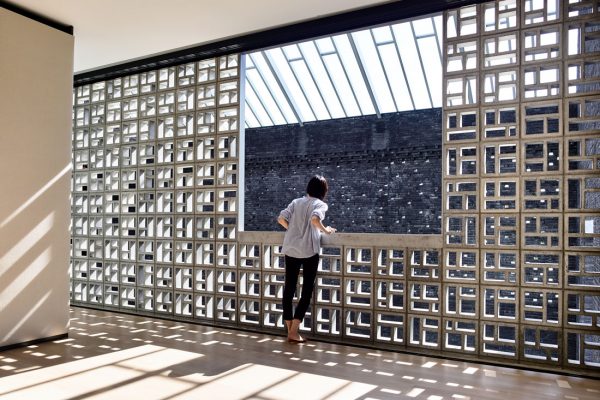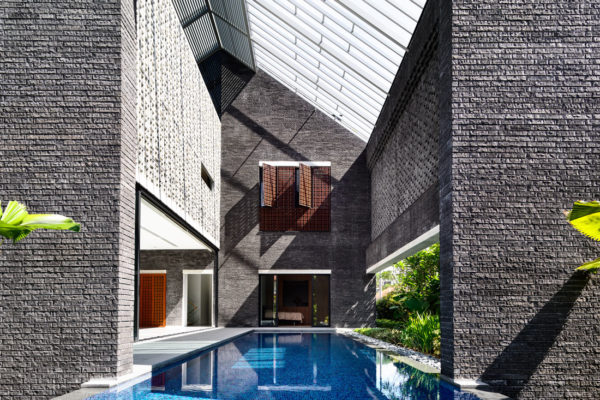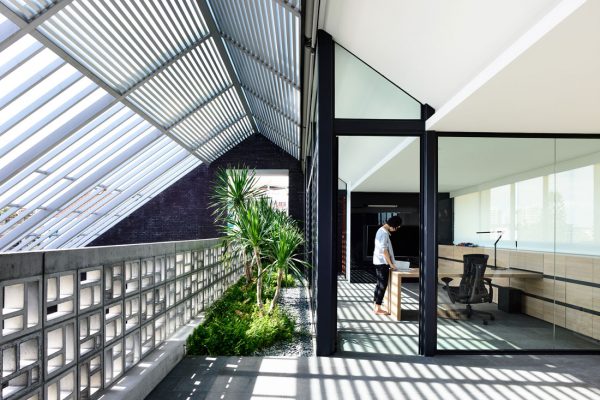Shortlisted in the INDE.Awards 2018, this home in Singapore’s east marks a bold development in HYLA Architects’ reinvention of the traditional courtyard house typology.

June 1st, 2018
When I arrive at this Siglap Plain home, architect Han Loke Kwang (Principal of HYLA Architects) invites me first to view the house from across the road. We cross the quiet street and look upon the grey, gable front form. “It is as a child would draw a house,” Han comments.
The building’s monolithic silhouette would have registered as a solemn semantic statement of the house as an icon, except the punctures it bears indicate a more contemporary and innovative spirit. Han has played with offsets in the size and positioning of the house’s front portals. “The form is symmetric but the openings are asymmetric,” he says. “These openings reveal the concept of the house – but not totally.”
The house falls in line with what Han calls his “courtyard houses” – buildings designed to enjoy exterior spaces while simultaneously finding privacy. Outside, one gets a suggestion of its spaces, but not of its activities. We see the car porch on one side, and an intriguing atrium-like space on the other. Han explains:
The motivation for such courtyards is multi-fold. “We have nothing to look at in most of the sites in Singapore. The plot sizes are usually quite small, so they don’t have a big garden,” says Han. “We thought, if we can’t find anything to look at, maybe we can find a way to look within.” Apart from views, Han’s design and placement of such courtyards also afford the greater house free-flowing air and plenty of natural light, as well as a level of privacy in the exterior spaces. “By enclosing the outdoor areas, we reclaim a bigger share of the outdoor area into the house. For most houses the external spaces are all around, but they are outside, so here I blur the distinction between inside and outside,” says Han.

In the case of Room Without Roof, a pool has been placed in the courtyard. The pool abuts the guest room on one end, continuing down the length of dining and living areas before extending out towards the landscaping. The enclosing brick wall and peripheral garden provide privacy, while the atrium remains open overhead, giving the residents a nice connection to the tropical weather – rain or shine. Still more important to the family is the relationship of the pool atrium to the rest of the house; the adjoining living spaces and the upper levels that look into it. Lee, the patriarch, says: “The living room is a common area for our family to gather when we are unwinding at the end of the day. Having a view of a pool, instead of a TV, is calming and also encourages conversations. My grandchildren like to play in the pool – although I am unable to swim, watching them and seeing them happy brings me great joy.”
The design of the house also involved considerations for the needs of a multi-generational household. “At that time, I was retired and had more time to spend at home with my family. Essentially, the new house had to be future-proof as we are largely an ageing household; I needed a lift and the interior to be elderly friendly,” says Lee.
“I also like my son and his family to live with us, as I did with my mother before her death, thus it needed to have enough space for their needs. My daughters, together with their families, also visit regularly. As such we need a big living room and dining area. I also wanted the house to be adequately self-contained with a pool, gym [and] home theatre so that the entire family can do their leisure activities within the house. The design was largely left to Han and his team after we told him about our needs and lifestyle.”

My visit to the house yields more surprises as we explore its interior. Entrance to the living areas is a gentle incline of steps, as the house is raised almost a metre (following building guidelines for this low-lying area). The living and dining areas share a span of space, which, having no columns and adjoined by the voluminous courtyard atrium, feels remarkably spacious – quite the perfect setting for big family gatherings. On more placid days, one enjoys the house in quieter ways. The breeze, welcomed through those large front openings, passes over the pool and into the living area. The Bianco Venatino marble underfoot feels cool on this incredibly hot morning. Stepping out to the courtyard, one is presented with even greater enjoyment of the architecture, particularly of the latticework and the brick construction, both of which partake in the daily play of light and shadow.
Privacy and personal spaces for individual family members is another key consideration of the architecture. Mini-courtyards are enjoyed from the privacy of bedrooms. A junior master suite occupies the entire attic level, planned for Lee’s son who has just started his own family. Even if relatively private, the attic and other such spaces (including Lee’s own study) look down to the pool atrium – where, of course, the family retires.

Room Without Roof is a wonderful design of relationships – in both spatial and familial terms. While beautifully built and detailed, the success of the house is in large part due to how it serves the family, particularly in the ways it addresses the needs for connection and privacy. On this, Lee says, “Han has completed a beautiful house for our family. We are living here comfortably.” A testimonial as simple and as solid as a brick house.
Photography by Derek Swalwell.
This feature was originally published in Habitus, issue 39.
A searchable and comprehensive guide for specifying leading products and their suppliers
Keep up to date with the latest and greatest from our industry BFF's!

The Sub-Zero Wolf showrooms in Sydney and Melbourne provide a creative experience unlike any other. Now showcasing all-new product ranges, the showrooms present a unique perspective on the future of kitchens, homes and lifestyles.

Create a configuration to suit your needs with this curved collection.

Suitable for applications ranging from schools and retail outlets to computer rooms and X-ray suites, Palettone comes in two varieties and a choice of more than fifty colours.

In the pursuit of an uplifting synergy between the inner world and the surrounding environment, internationally acclaimed Interior Architect and Designer Lorena Gaxiola transform the vibration of the auspicious number ‘8’ into mesmerising artistry alongside the Feltex design team, brought to you by GH Commercial.

DKO’s Interior Design Director on how to create community and specificity in interior design, and how apartment living is being reconceptualised.

We spoke with Tilt’s Managing and Creative Director about industrial design, innovative technology and wellbeing within education spaces.
The internet never sleeps! Here's the stuff you might have missed

Savage Design’s approach to understanding the relationship between design concepts and user experience, particularly with metalwork, transcends traditional boundaries, blending timeless craftsmanship with digital innovation to create enduring elegance in objects, furnishings, and door furniture.

Drawing on the concept of a watering hole as a gathering place in nature, GroupGSA has rejuvenated Sydney Water’s headquarters located in Parramatta.